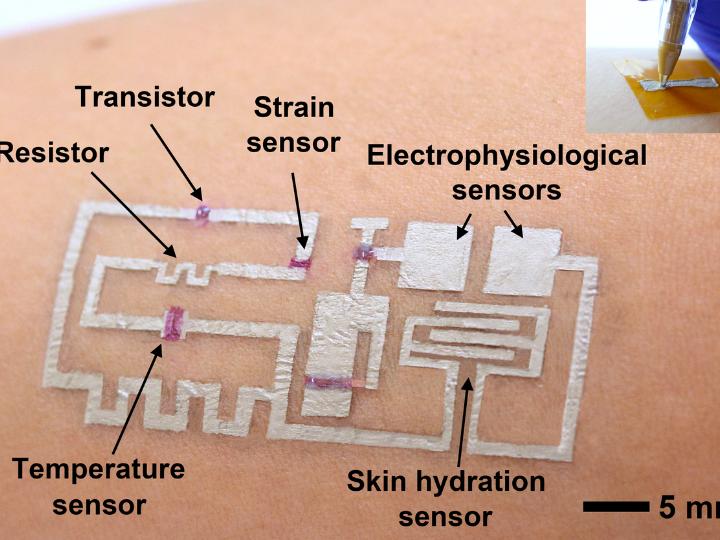This news is intriguing since they usually want to enhance memory not weaken it. Interestingly, this October 3, 2022 news item on ScienceDaily doesn’t immediately answer why you might want to weaken memory,
Robotics and wearable devices might soon get a little smarter with the addition of a stretchy, wearable synaptic transistor developed by Penn State engineers. The device works like neurons in the brain to send signals to some cells and inhibit others in order to enhance and weaken the devices’ memories.
Led by Cunjiang Yu, Dorothy Quiggle Career Development Associate Professor of Engineering Science and Mechanics and associate professor of biomedical engineering and of materials science and engineering, the team designed the synaptic transistor to be integrated in robots or wearables and use artificial intelligence to optimize functions. The details were published on Sept. 29 [2022] in Nature Electronics.
“Mirroring the human brain, robots and wearable devices using the synaptic transistor can use its artificial neurons to ‘learn’ and adapt their behaviors,” Yu said. “For example, if we burn our hand on a stove, it hurts, and we know to avoid touching it next time. The same results will be possible for devices that use the synaptic transistor, as the artificial intelligence is able to ‘learn’ and adapt to its environment.”
…
A September 29, 2022 Pennsylvania State University (Penn State) news release (also on EurekAlert but published on October 3, 2022) by Mariah Chuprinski, which originated the news item, explains why you might want to weaken memory,
According to Yu, the artificial neurons in the device were designed to perform like neurons in the ventral tegmental area, a tiny segment of the human brain located in the uppermost part of the brain stem. Neurons process and transmit information by releasing neurotransmitters at their synapses, typically located at the neural cell ends. Excitatory neurotransmitters trigger the activity of other neurons and are associated with enhancing memories, while inhibitory neurotransmitters reduce the activity of other neurons and are associated with weakening memories.
“Unlike all other areas of the brain, neurons in the ventral tegmental area are capable of releasing both excitatory and inhibitory neurotransmitters at the same time,” Yu said. “By designing the synaptic transistor to operate with both synaptic behaviors simultaneously, fewer transistors are needed [emphasis mine] compared to conventional integrated electronics technology, which simplifies the system architecture and allows the device to conserve energy.”
To model soft, stretchy biological tissues, the researchers used stretchable bilayer semiconductor materials to fabricate the device, allowing it to stretch and twist while in use, according to Yu. Conventional transistors, on the other hand, are rigid and will break when deformed.
“The transistor is mechanically deformable and functionally reconfigurable, yet still retains its functions when stretched extensively,” Yu said. “It can attach to a robot or wearable device to serve as their outermost skin.”
In addition to Yu, other contributors include Hyunseok Shim and Shubham Patel, Penn State Department of Engineering Science and Mechanics; Yongcao Zhang, the University of Houston Materials Science and Engineering Program; Faheem Ershad, Penn State Department of Biomedical Engineering and University of Houston Department of Biomedical Engineering; Binghao Wang, School of Electronic Science and Engineering, Southeast University [Note: There’s one in Bangladesh, one in China, and there’s a Southeastern University in Florida, US] and Department of Chemistry and the Materials Research Center, Northwestern University; Zhihua Chen, Flexterra Inc.; Tobin J. Marks, Department of Chemistry and the Materials Research Center, Northwestern University; Antonio Facchetti, Flexterra Inc. and Northwestern University’s Department of Chemistry and Materials Research Center.
Here’s a link to and a citation for the paper,
An elastic and reconfigurable synaptic transistor based on a stretchable bilayer semiconductor by Hyunseok Shim, Faheem Ershad, Shubham Patel, Yongcao Zhang, Binghao Wang, Zhihua Chen, Tobin J. Marks, Antonio Facchetti & Cunjiang Yu. Nature Electronics (2022) DOI: DOI: https://doi.org/10.1038/s41928-022-00836-5 Published: 29 September 2022
This paper is behind a paywall.
